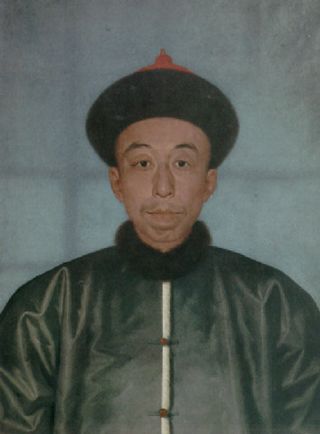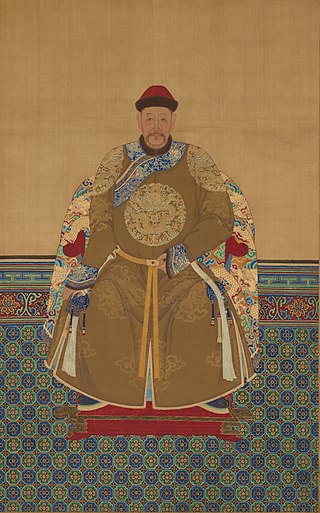Related Research Articles

Prince Guo of the First Rank, or simply Prince Guo, was the title of a princely peerage used in China during the Manchu-led Qing dynasty (1644–1912). As the Prince Guo peerage was not awarded "iron-cap" status, this meant that each successive bearer of the title would normally start off with a title downgraded by one rank vis-à-vis that held by his predecessor. However, the title would generally not be downgraded to any lower than a feng'en fuguo gong except under special circumstances.

Daišan was an influential Manchu prince and statesman of the Qing dynasty.
Duanhua was a Manchu prince and regent of the Qing dynasty.
Jirgalang or Jirhalang was a Manchu noble, regent, and political and military leader of the early Qing dynasty. Born in the Aisin Gioro clan, he was the sixth son of Šurhaci, a younger brother of Nurhaci, the founder of the Qing dynasty. From 1638 to 1643, he took part in many military campaigns that helped destroy the Ming dynasty. After the death of Huangtaiji in September 1643, Jirgalang became one of the young Shunzhi Emperor's two co-regents, but he soon yielded most political power to co-regent Dorgon in October 1644. Dorgon eventually purged him of his regent title in 1647. After Dorgon died in 1650, Jirgalang led an effort to clean the government of Dorgon's supporters. Jirgalang was one of ten "princes of the first rank" (和碩親王) whose descendants were made "iron-cap" princes (鐵帽子王), who had the right to transmit their princely titles to their direct male descendants perpetually.
Prince An of the First Rank, or simply Prince An, was the title of a princely peerage used in China during the Manchu-led Qing dynasty (1644–1912). As the Prince A peerage was not awarded "iron-cap" status, this meant that each successive bearer of the title would normally start off with a title downgraded by one rank vis-à-vis that held by his predecessor. However, the title would generally not be downgraded to any lower than a feng'en fuguo gong except under special circumstances.
Šurhaci, was a Jurchen leader, a member of the Aisin Gioro clan, he was a younger brother of Nurhaci, the founder of the Later Jin dynasty, the predecessor of the Qing dynasty. Under the Ming dynasty government, he held the title of local chieftain (都指揮) in the Jianzhou district, and maintained relations with the Ming authorities up to the beginning of 1607. In that year, he joined Nurhaci in the campaign against Bujantai and the Ula tribe, receiving the title of darhan baturu. However, as a result of disagreements with his brother over the conquest of the Hoifa and the killing of Hoifa's beile Baindari in 1607, he was put to death four years later at Nurhaci's order and buried in Dongjingling Township, Liaoyang. In 1653, he was posthumously given the rank of qinwang under the posthumous title Prince Zhuang of the First Rank.
Prince Yu of the First Rank, or simply Prince Yu, was the title of a princely peerage used in China during the Manchu-led Qing dynasty (1644–1912). It was also one of the 12 "iron-cap" princely peerages in the Qing dynasty, which meant that the title could be passed down without being downgraded.
Prince Keqin of the Second Rank, or simply Prince Keqin, was the title of a princely peerage used in China during the Manchu-led Qing dynasty (1644–1912). It was also one of the 12 "iron-cap" princely peerages in the Qing dynasty, which meant that the title could be passed down without being downgraded.
Prince Shuncheng of the Second Rank, or simply Prince Shuncheng, was the title of a princely peerage used in China during the Manchu-led Qing dynasty (1644–1912). It was also one of the 12 "iron-cap" princely peerages in the Qing dynasty, which meant that the title could be passed down without being downgraded.
Prince Su of the First Rank, or simply Prince Su, was the title of a princely peerage of the Manchu-led Qing dynasty of China (1644–1912). It was also one of the 12 "iron-cap" princely peerages in the Qing dynasty, which meant that the title could be passed down without being downgraded.
Prince Zhuang of the First Rank, or simply Prince Zhuang, was the title of a princely peerage used in China during the Manchu-led Qing dynasty (1644–1912). It was also one of the 12 "iron-cap" princely peerages in the Qing dynasty, which meant that the title could be passed down without being downgraded.
Prince Heng of the First Rank, or simply Prince Heng, was the title of a princely peerage used in China during the Manchu-led Qing dynasty (1644–1912). As the Prince Heng peerage was not awarded "iron-cap" status, this meant that each successive bearer of the title would normally start off with a title downgraded by one rank vis-à-vis that held by his predecessor. However, the title would generally not be downgraded to any lower than a feng'en fuguo gong except under special circumstances.
Prince Yi of the First Rank, or simply Prince Yi, was the title of a princely peerage used in China during the Manchu-led Qing dynasty (1644–1912). It was also one of the 12 "iron-cap" princely peerages in the Qing dynasty, which meant that the title could be passed down without being downgraded.
Prince Li of the First Rank, or simply Prince Li, was the title of a princely peerage of the Manchu-led Qing dynasty of China. It was also one of the 12 "iron-cap" princely peerages in the Qing dynasty, which meant that the title could be passed down without being downgraded.
Prince Rui of the First Rank, or simply Prince Rui, was the title of a princely peerage used in China during the Manchu-led Qing dynasty (1644–1912). It was also one of the 12 "iron-cap" princely peerages in the Qing dynasty, which meant that the title could be passed down without being downgraded.
Prince Dun of the First Rank, or simply Prince Dun, was the title of a princely peerage used in China during the Manchu-led Qing dynasty (1644–1912). As the Prince Dun peerage was not awarded "iron-cap" status, this meant that each successive bearer of the title would normally start off with a title downgraded by one rank vis-à-vis that held by his predecessor. However, the title would generally not be downgraded to any lower than a feng'en fuguo gong except under special circumstances.
Ledu was a Qing dynasty imperial prince, Jirgalang's third son and grandson of Nurhaci's third younger brother Šurhaci. He was a sole holder of the Prince Min of the Second Rank title from 1651 to his death in 1655. As the peerage was not given perpetual inheritability, his descendants would have held diminished titles vis-a-vis their predecessors. The peerage became extinct because of lack of a male heir.
Jidu was Qing dynasty imperial prince as the second son of Jirgalang, Nurhaci's nephew. Jidu was the second holder of Prince Zheng title under the name "Prince Jian of the First Rank". The previous name was restored only in 1778.
Mandahai, was an imperial prince of the Qing dynasty and one of Nurhaci's grandson. He was the seventh son of Daišan and in 1649 he inherited his father's princedom. He was posthumously honoured as Prince Xunjian of the First Rank (巽簡親王).
Yunki, born Yinqi and formally known as Prince Heng of the First Rank, was an imperial prince of the Manchu ruled Qing dynasty. He was the fifth son of the Kangxi Emperor who survived to adulthood.
References
- Zhao, Erxun (1928). Draft History of Qing (Qing Shi Gao). Vol. 215. China.
{{cite book}}: CS1 maint: location missing publisher (link)